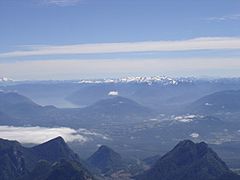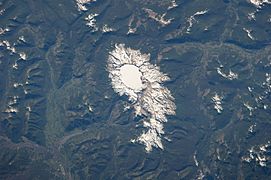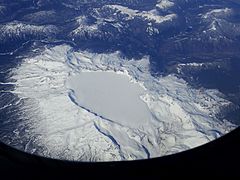Sollipulli facts for kids
Quick facts for kids Sollipulli |
|
|---|---|

Aerial photograph of volcan Sollipulli, looking southeast. The dark red feature on the side of Sollipulli is the cinder cone called Chufquen which formed during the most recent eruption, about 700 years ago.
|
|
| Highest point | |
| Elevation | 2,282 m (7,487 ft) |
| Listing | List of volcanoes in Chile |
| Geography | |
| Location | Southern Chile |
| Parent range | Andes |
| Geology | |
| Mountain type | Caldera |
| Volcanic arc/belt | Southern Volcanic Zone of the Andes |
| Last eruption | 1240 ± 50 years |
Sollipulli is a fascinating volcano in Chile. Its name means "reddish mountain" in the Mapuche language. It's a special type of volcano called a caldera, which is like a big, bowl-shaped hole formed when a volcano collapses. What makes Sollipulli extra unique is that this huge bowl is filled with a thick layer of ice!
Sollipulli is located in the La Araucanía Region of Chile, southeast of the town of Melipeuco. It's part of a chain of volcanoes called the Southern Volcanic Zone in the Andes mountains. This volcano has grown and changed a lot while being surrounded by glacial ice. Unlike many calderas that form from huge explosions, Sollipulli's caldera seems to have collapsed without a big blast. The ice inside can be as thick as 650 meters (about 2,130 feet)! This ice slowly moves out through two glaciers on the west and north sides of the caldera.
Sollipulli has been active for a very long time, through the Pleistocene and Holocene periods. A massive eruption happened about 2,960–2,780 years ago. This eruption created the Alpehué crater and sent a tall column of ash and gas into the sky. The most recent activity was about 710 years ago. This event formed a small cone called Chufquén on the volcano's northern side. Sollipulli is one of many volcanoes in the Andes that have been active in recent history.
Contents
Exploring Sollipulli's Shape and Location
Sollipulli is found in the Araucanía Region, in an area called the Melipeuco commune. It's part of a mountain range known as Nevados de Sollipulli. Nearby towns include Melipeuco, which is about 20 kilometers (12 miles) to the northwest. The volcano is also part of the Kütralkura geopark project, which helps protect and teach people about the area's geology.
Sollipulli in the Andes Mountains
Sollipulli is a key part of the Southern Volcanic Zone of the Andes. The Andes mountain range has four main groups of volcanoes. These volcanic zones are separated by areas where there's no volcanic activity. This happens because the Pacific Ocean crust goes deeper under the ground in those areas. About 60 volcanoes in the Andes have erupted in recorded history. Another 118 volcanoes show signs of eruptions in the last 10,000 years.
The Southern Volcanic Zone has about 60 volcanoes. Some, like Cerro Azul and Cerro Hudson, had huge eruptions in the past, sending out lots of ash. Other volcanoes, such as Llaima and Villarrica, are often active.
Sollipulli's Unique Features
Sollipulli is a stratovolcano, which means it's built up from many layers of hardened lava and ash. It has a large, 4-kilometer (2.5-mile) wide caldera at its top. To the southwest, there's another crater called Alpehué, which is about 1 kilometer (0.6 miles) wide. The edges of the main caldera rise about 150 meters (490 feet) above the ice inside. The highest point of Sollipulli is on the southern side of the caldera, reaching 2,282 meters (7,487 feet) above sea level.
The volcano is made of different materials like lava flows, lava domes, and pumice. It's a very large volcano, covering about 250 square kilometers (96 square miles). Many of Sollipulli's unique shapes were formed by the movement of glaciers.
The Nevados de Sollipulli mountain chain, west of the caldera, is made of older, worn-down volcanoes. Glaciers have carved out bowl-shaped valleys called cirques there. Closer to the main caldera, the volcano's features are better preserved. The sides of Sollipulli are covered by lava flows, which give them an uneven shape. Glaciers and rivers have also carved valleys into the slopes. There are about a dozen smaller craters on the volcano's sides, including Chufquén and Redondo on the northern side.
Glaciers Inside Sollipulli
Both the main caldera and the Alpehué crater hold glaciers. In 1992, the ice in the main caldera was about 650 meters (2,130 feet) thick. This glacier has typical ice features like deep cracks called crevasses. There might even be a lake hidden under the ice! Three lakes are found at the edges of the caldera: Sharkfin Lake, Dome Lake, and Alpehué Lake.
These glaciers flow out to the north and northwest. One glacier flows from the caldera through the Alpehué crater and into the Alpehué valley. This valley is drained by the Rio Alpehué river, which flows into the Rio Allipén. Besides these caldera and crater glaciers, Sollipulli only has seasonal snow cover. Glaciers have been on the volcano for a very long time, even before the last major ice age. They've left marks on the rocks and evidence of eruptions that happened under the ice.
The glacier inside Sollipulli's caldera is getting smaller. Its surface area shrank between 1961 and 2011. The Alpehuén outlet glacier also pulled back by 1.3 kilometers (0.8 miles). Some smaller ice fields around Sollipulli have either shrunk or disappeared completely. This melting might be speeding up because ash from nearby volcanoes like Puyehue-Cordón Caulle, Llaima, and Villarrica lands on the ice. In 2011, the glacier's volume was estimated to be about 4.5 cubic kilometers (1.1 cubic miles). If the glacier melts too much, it could cause dangerous mudflows called lahars and affect the region's water supply.
-
Nevados de Solipulli seen from Villarrica volcano
How Sollipulli Formed
The Andes mountains and their volcanoes formed because the Pacific Ocean crust has been slowly sliding under South America for millions of years. This process is called subduction.
Sollipulli volcano sits on older rock layers. These layers include ancient rock formations from the Jurassic and Cretaceous periods, as well as younger volcanic rocks. Two major fault lines, the Liquiñe-Ofqui Fault Zone and the Reigolil-Pirihueico fault, pass near Sollipulli. These faults are like cracks in the Earth's crust that can help magma rise to the surface.
What Sollipulli's Rocks Are Made Of
The rocks that have erupted from Sollipulli are a mix of different types, including basalt, andesite, and dacite. The type of rock has changed over the volcano's history. These rocks contain various minerals like olivine and plagioclase. Sometimes, pieces of older rocks are found inside newer ones.
Scientists believe that the rocks from the Alpehué area formed when new, hot magma mixed with older magma deep inside the volcano. Sometimes, this new magma can even create smaller vents on the sides of the volcano.
A type of volcanic glass called Obsidian was found on Sollipulli. This obsidian was traded far and wide, even reaching Argentina and northern Chile. It looks and is chemically different from obsidian found at other volcanoes. One source of this obsidian has been found at a lava dome on Sollipulli's western side.
Plants and Weather Around Sollipulli
The area around Sollipulli gets a lot of rain, about 2.1 meters (6.9 feet) per year, mostly between April and September. The region is covered in forests with deciduous trees (trees that lose their leaves), like Nothofagus. There are also laurel forests near the lakes and woods of Araucaria araucana (monkey puzzle trees) and Austrocedrus chilensis at higher elevations. Open grasslands, called mallines, were used for grazing animals.
Sollipulli's Eruption History
Sollipulli was active during the Pleistocene and Holocene epochs. The Nevados de Sollipulli volcanoes are less than 1.8 million years old. Scientists have studied six different volcanic layers that make up Sollipulli. The oldest layers might have formed around the same time as the caldera, or even before it. Many of the younger layers show clear signs of being changed by glaciers.
A large eruption from the Alpehué crater happened about 2,960–2,780 years ago. This was a powerful Plinian eruption, which created a huge eruption column that reached 44 kilometers (27 miles) high! It ejected about 7.5 cubic kilometers (1.8 cubic miles) of pumice. Ash from this eruption has been found in lakes nearby and even as far away as Argentina and Antarctica. This ash has been very useful for scientists to date other events in history. The hot ash flows from this eruption melted the caldera ice, causing dangerous mudflows called lahars to flow away from the volcano.
The most recent eruption happened about 710 years ago, creating the Chufquén cone. This eruption deposited ash onto the caldera ice. Since this eruption was relatively recent, it shows that Sollipulli is still an active volcano. Today, you can find fumaroles (steam vents) and other hot spots at the northwestern base of Sollipulli.
There's also a special geothermal area called Alpehue, about 4.5 kilometers (2.8 miles) southwest of the Alpehue crater. It's unusual because it has geysers, which are like natural hot water fountains! Other features include hot springs and mud pools. These geysers can shoot water up to 2.5 meters (8 feet) high. This geyser field has been active for at least 7,400 years.
Potential Dangers from Sollipulli
Because Sollipulli has a large amount of ice in its caldera, there's a big risk of mudflows or sudden floods (called glacier bursts) if the volcano becomes active again. On the other hand, if the glacier melts and shrinks, it might make it easier for explosive eruptions to happen. If an eruption like the ancient Alpehué event happened again, it would be a major disaster for the region, similar to the 1991 eruption of Cerro Hudson volcano.
The Chilean geological service, Sernageomin, keeps a close eye on Sollipulli and tells people about its hazard level. Towns like Cunco, Melipeuco, and Villa García are close to the volcano. Melipeuco even has an emergency plan ready for future eruptions from Sollipulli or the nearby Llaima volcano.
See also
 In Spanish: Sollipulli para niños
In Spanish: Sollipulli para niños






